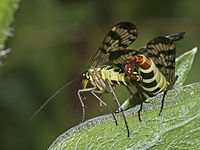Panorpa communis
| Panorpa communis | |
|---|---|

| |
| P. communis male with prey | |

| |
| P. communis female | |
| Scientific classification | |
| Domain: | Eukaryota |
| Kingdom: | Animalia |
| Phylum: | Arthropoda |
| Class: | Insecta |
| Order: | Mecoptera |
| Family: | Panorpidae |
| Genus: | Panorpa |
| Species: | P. communis
|
| Binomial name | |
| Panorpa communis | |
Panorpa communis, the common scorpionfly,[1] is a species of scorpionfly.
Distribution
This species is native to
Habitat
These scorpionflies can be usually found in
Description

Panorpa communis can reach a body length of about 30 millimetres (1.2 in).[6] The common scorpionfly has a black and yellow body, with a reddish head and tail. The male has a pair of claspers at the end of its tail (for holding the female during mating),[6] giving it a scorpion-like appearance,[6] although it is not a stinger.
The adult insect has a wingspan of about 35 millimetres (1.4 in),[6] with wings that are mostly clear, but have many dark spots or patches. Its head, mounted with large eyes, is drawn into a prominent, downward pointing beak,[6] which opens at the tip of its head. Females are longer, heavier, and have longer legs than males.[7]
In the female, the eighth abdominal segment is the shortest, almost twice shorter than the seventh; the sixth is narrowed towards the back.[8] The larva resembles a caterpillar and grows up to 20 millimetres (0.79 in) long. It has three pairs of thoracic legs and eight pairs of prolegs.[9]
Biology and habits
The adult is seen between May and September.[6] They eat dead insects (although they sometimes eat live aphids), sometimes taking them from spider webs[6] and plant sap.[10]
Although fully winged, the adults rarely fly very far and spend much of their time crawling on vegetation in damp, shaded places near water and along hedgerows. Panorpa communis is a univoltine species.[6] Eggs are laid in soil annually and the larvae both scavenge and pupate there.[6]
Mating behavior
Males release pheromones and offer nuptial gifts to females in the form of saliva secretions and nuptial prey (usually dead arthropods).[11] Before offering the nuptial gifts, the male and female, perform ritualized premating behavior, which includes slow wing movements, accompanied by brief sequences of rapid vibrations from their abdomen.[11] The mating success of females increases with the size of nuptial gifts offered by the male.[11]
Gallery
-
Mating (female on the right)
-
Head detail
-
Wing detail
-
Male genitalia
-
Video clip
References
- ^ in Kendall Bioresearch
- doi:10.24189/ncr.2023.001.)
{{cite journal}}: CS1 maint: multiple names: authors list (link - ^ Fauna europaea
- ^ "Catalogue of life". Archived from the original on 2019-05-06. Retrieved 2018-04-18.
- ^ Range at GBIF
- ^ a b c d e f g h i j UK Safari
- ISSN 1477-9145.
- ^ F. C. Fraser: Handbooks for the identification of British Insects. Vol. I. part 12 and 13. Mecoptera, Megaloptera, Neuroptera. London: Royal Entomological Society of London, 1959, s. 8–10
- ^ Strange animals
- ^ "food" in uksafari.com
- ^ PMID 24818592.
External links
- Peter Holden, Geoffrey Abbott RSPB Handbook of Garden Wildlife
- Bloomsbury Concise Garden Wildlife Guide





